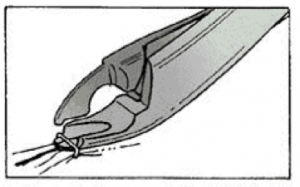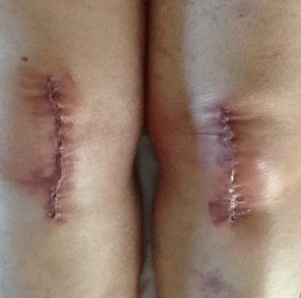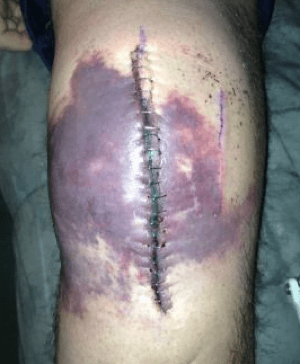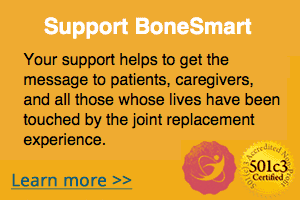What to expect once you leave the hospital
Once you’re home, it’s a good idea to go over the discharge instructions once again with a friend or family member, paying particular attention to the guidance you are to follow for wound care. There will be a contact number for your surgeon’s office should you have any questions or concerns. Basic instruction usually consists of keeping the wound clean, dry, and covered with a dressing and bandage as directed by your surgeon. Having this protection over the wound in these early days usually provides an extra measure of comfort for you, as you don’t have to worry about staples or stitches catching on clothing or slight bumps that may occur as you move about. The bandage is normally left in place until your staples or stitches are removed (probably at 10-14 days out from surgery).
Home Health Visits
If your surgeon ordered Home Health visits for you, you’ll have an initial visit by the nurse the first day or two you are home. The nurse will keep track of your vital signs (blood pressure, temperature, pulse rate) and generally observe you to be sure there are no medical problems. Procedures can vary in different countries. In the USA, your nurse will routinely inspect your wound and change your dressing at each visit. However, in the UK surgeons prefer that the original dressing is left in place and not disturbed until the staples or stitches are removed. The nurse is your surgeon’s eyes and ears, so be sure and communicate any concerns immediately so they can be passed on to your doctor’s office. Care from your Home Health nurse may include removal of your sutures or staples between 10 and 14 days following surgery. Be sure to follow whatever guidelines are set forth by your own medical team. Each surgeon will have their own protocols to follow.
Self-care of Wounds
In the US, if you don’t have a Home Health nurse or in between visits, it is possible to care for your wound yourself. Expect some drainage or blood on the bandage, especially in the early days. Should you need to change the dressing, follow these steps:
- Wash your hands well with soap and water and dry with a clean towel.
- Remove the bandage and dressing carefully and DO NOT pull hard. If you need to, soak some of the dressing with hypochlorous (HOCL) or saline solution to help loosen it.
- Soak some clean gauze with hypochlorous and lightly wipe from one end of the incision to the other. DO NOT wipe back and forth over the same area to prevent any contamination in the wound.
- You can use a cotton swab and hypochlorous or saline solution to gently remove any dried blood or crust that has formed.
- Dry the incision the same way with clean, dry gauze. Wipe or pat in just 1 direction.
- Check your wound for signs of infection. These include severe swelling and redness or drainage that has a bad odor.
- Apply a new dressing, ensuring the entire wound is covered with non-stick gauze. Do not put tape over the wound itself.
It is possible your wound will be completely closed in as little as 48 hours. If this is the case, you can expose the incision to air provided your surgeon has not advised you to keep the wound covered until staples or stitches are removed. But it’s also possible that your wound will continue with some slight drainage for a few days. If this is the case, it should remain covered. As you progress through the recovery process, you may decide to cover your incision to prevent irritation if you find it becomes sensitive to clothing or bedding. Change your dressing if it gets wet or soiled.
Hypochlorous solution and saline as well as extra-long bandages can be purchased at your local drug store or from online sources such as Amazon.com.
Sutures (stitches) or staples will be removed about 10 to 14 days after surgery. Adhesive skin closures and glue are usually left untouched until they fall off naturally.
Since adhesive skin closures are only applied to a sealed wound, showering should be permitted with them in place and it does not matter if they get wet. They can be dried along with the rest of the body and removed completely after 7 days if they don’t fall off naturally before that time. To leave them on longer than 7 days means the partially separated ends of the strips may pick up debris from clothing and bedding, making them a contamination risk. To remove adhesive strips if they don’t come loose on their own, you can gently pull them off. If they are still tightly adhered, put mineral oil or petroleum jelly on a cotton ball and gently rub each strip until it comes off easily.
If your wound is closed with glue, be sure to avoid situations where you might perspire excessively. Don’t put any liquid, ointment, or cream on your wound while the glue is in place. Protect the wound from sunlight and do not scratch, rub, or pick at the glue or put tape directly over it. The glue should peel off within 5 to 10 days.
Use of Hypochlorous (HOCL) Solution on Your Wound
While you must not use any lotions or creams on your incision in the first months following surgery, the use of a Hypochlorous (HOCL) Solution is recommended to reduce the chance of infection and to promote healing.
Hypochlorous solution has a variety of uses and it kills 99.9% of all bacteria upon contact. It can help prevent scarring by speeding your body’s natural recovery process. Because it is the same molecule your own body creates to kill bacteria, reduce skin inflammation and help the body heal, it does not irritate skin or sting upon application. The solution is natural, non-toxic and antibiotic free, making it safe to use on an open wound like your incision right after surgery.
Showering
Usually you may shower 3 to 4 days after surgery but be sure to get approval from your surgeon first. If for some reason you must keep the incision dry for more than a few days, you can wrap the wound and dressing area with self-stick Glad Wrap prior to the shower. Once you have approval to shower normally, let the water run over the incision but do not scrub the area or let the water beat down on it. DO NOT soak in a bathtub, hot tub, or swimming pool.
After your shower, pat the wound dry carefully with a clean towel. Replace the bandage if that is more comfortable for you or if you are still having drainage. If you’re in the UK and you still have your staples or stitches in place, you’ll need to contact your nurse to have a wet bandage replaced.
Do not put any lotions or creams on the wound itself before it is fully healed and all staples, sutures or adhesive skin closures are removed.
Removal of Sutures or Skin Staples
Sutures are normally removed by your Home Health nurse or your surgeon’s staff. This is a relatively painless process for the patient.
Staples used in surgery are made of inert wire, usually titanium, and are about 0.5mm thick. With the correct applicator and removal instrument they are easily formed for insertion and removal.
The staple’s construction is a unique design that folds up and makes a box shaped ‘stitch’ which holds the skin edges together but slightly elevated from the natural skin level.

When they are removed, a special sterile instrument is used to bend the staple into an M shape, opening the “legs” at a right angle to the skin.

Each staple can then be lifted out with minimal pain. This is NOT something you should attempt on your own. Either your Home Health nurse or someone at your surgeon’s office will take care of this for you when the time is right. Should your incision be swollen, the staples can get slightly buried and removal may be a bit more uncomfortable. So it’s a good idea to keep an eye on your wound so you can notify your Home Health nurse or surgeon’s office before they get too far under the skin. You want a prompt removal just at the point where the wound has closed completely, but no later.
Problems That May Occur with Your Incision
Keep a close eye on your incision to ensure it is healing properly. However, even under perfect conditions, problems can develop. Most are minor and can be handled without a trip to your surgeon’s office.
Bruising or redness around the wound
You may have bruising around your wound, especially if a wound vac is not used. This is normal, and it will go away on its own. Using witch hazel on the bruised area can be a soothing treatment.

The skin around your incision could also be a little red and warm. This too is normal and is usually a sign that cellular activity (healing) is taking place.








